
Looking for Apple Sauce: Making and Bottling Your Own HomeMade Applesauce! in 2025? Scroll down this page and follow the links. And if you bring home some fruit or vegetables and want to preserve, freeze, make jam, salsa or pickles, see this page for simple, reliable, illustrated preserving, freezing or bottling directions. There are plenty of other related resources, click on the resources dropdown above.
If you have questions or feedback, please let me know! There are affiliate links on this page. Read our disclosure policy to learn more.
Apple Sauce: Making and Bottling Your Own HomeMade Applesauce!
How to Make Homemade Applesauce
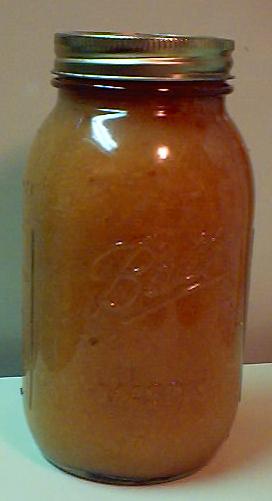 You think making and
bottling your own applesauce is
difficult or expensive? Not at all! Here's how to do it, complete instructions in easy steps and
completely illustrated. The applesauce will taste MUCH better than anything
you've ever had from a store, and by selecting the right apples, it will be so
naturally-sweet that you won't need to add any sugar at all.
It also makes a great natural baby food!
You think making and
bottling your own applesauce is
difficult or expensive? Not at all! Here's how to do it, complete instructions in easy steps and
completely illustrated. The applesauce will taste MUCH better than anything
you've ever had from a store, and by selecting the right apples, it will be so
naturally-sweet that you won't need to add any sugar at all.
It also makes a great natural baby food!
Prepared this way, the jars have a shelf life of 18 months to 2 years, and require no special attention.
I learned years ago how to make jam and applesauce watching my mother and grandmother when I was a child. My grandmother and mother always made it, and now if I want it, I've got to make it myself (funny how that growing up stuff works?)
And here's how you can, too. If you don't want to can the applesauce, but just want some fresh for a meal; see how to make applesauce for a meal (not bottling it) with NO special equipment.
Directions for Making Applesauce
Ingredients and Equipment
|
|
Recipe and Directions
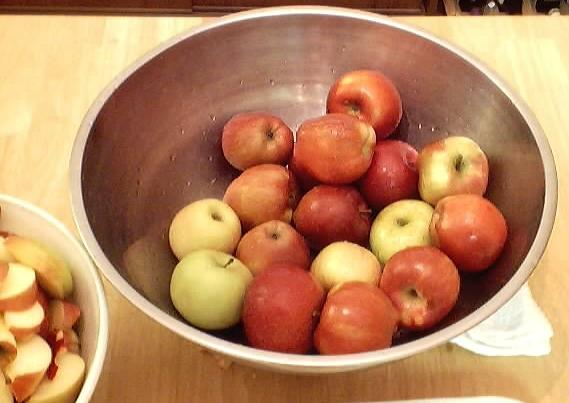 Step 1 - Selecting the apples
Step 1 - Selecting the apples
The most important step! You need apples that are sweet - NOT something tart like Granny Smith's. Yeah, I know you like them (why do sweet women like sour apples???) and even if I did, they still wouldn't make good applesauce - you'd have to add a lot of sugar.
Instead, choose apples that are naturally sweet, like Red Delicious, Gala, Fuji, Rome and always use a mixture - never just one type. This year I used 4 bushels of red delicious and one each of Fuji, Yellow Delicious, Gala and Rome. This meant it was so sweet I did not need to add any sugar at all. And the flavor is great! The Fuji's and Gala's give it an aromatic flavor! Honeycrisp and Pink Lady are also excellent, sweet, flavorful apples.
Step 2 - How many apples and where to get them
You can pick your own, or buy them at the grocery store. But for large quantities, you'll find that farms and PYO's have them at the best prices. In 2008, they were available from late September at £11 to £16 per bushel. 2009 prices have been in the £14 to £20 range
You'll get about 12 to 16 quarts of applesauce per bushel of apples. Count on 13 or 14 quarts per bushel.
 Step 3 - Wash the jars and lids
Step 3 - Wash the jars and lids
Now's a good time to get the jars ready, so you won't be rushed later. The dishwasher is fine for the jars; especially if it has a "sterilize" cycle, the water bath processing will sterilize them as well as the contents! If you don't have a dishwasher with a sterilize cycle, you can wash the containers in hot, soapy water and rinse, then sterilize the jars by boiling them 10 minutes, and keep the jars in hot water until they are used. Leave the jars in the dishwasher on "heated dry" until you are ready to use them. Keeping them hot will prevent the jars from breaking when you fill them with the hot applesauce.
Put the lids into a pan of hot, but not quite boiling water (that's what the manufacturer's recommend) for 5 minutes, and use the magnetic "lid lifter wand" to pull them out.
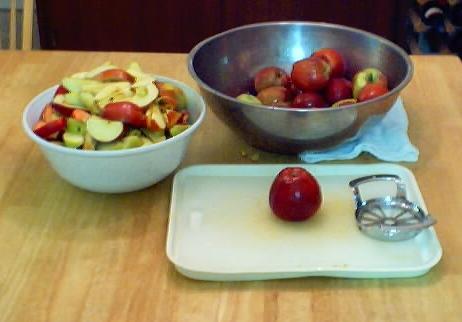 Step 4 -Wash and chop the apples!
Step 4 -Wash and chop the apples!
I'm sure you can figure out how to wash the apples in plain cold water.
Chopping them is much faster if you use one of those apple corer/segmenters - you just push it down on an apple and it cuts it into segments. Note: You do not peel the apples! You will put the entire apple into the pot to cook.
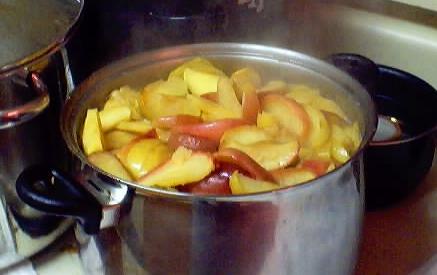 Step 5 - Cook the Apples
Step 5 - Cook the Apples
Pretty simple put about 1 inch of water (I used either filtered tap
water or store brand apple juice) on the bottom of a huge, thick-bottome d
pot. Put the lid on, and the heat on high. When it gets really
going, turn it to medium high until the apples are soft through and
through.
d
pot. Put the lid on, and the heat on high. When it gets really
going, turn it to medium high until the apples are soft through and
through.
Step 6 - Sieve the cooked apples
There are two ways to squish the apples through a sieve, either through a :
- hand-cranked Foley food mill (about £20 see this page or
- through a KitchenAid sieve/grinder (with the attachments, about £300, but it lasts a lifetime).
Click here for related items on Amazon
Click here for related items on Amazon
Click here for this and related items on Amazon
Click here for this and related items on Amazon
You CAN also use a simple metal sieve, but it will be VERY tedious, hard work.
Basically, you put the cooked apples (including the skins, seeds, cores and stems) into the top hopper, and use the wooden plunger to push it in.
NOTE for those on a VERY tight budget or making just a small batch of applesauce
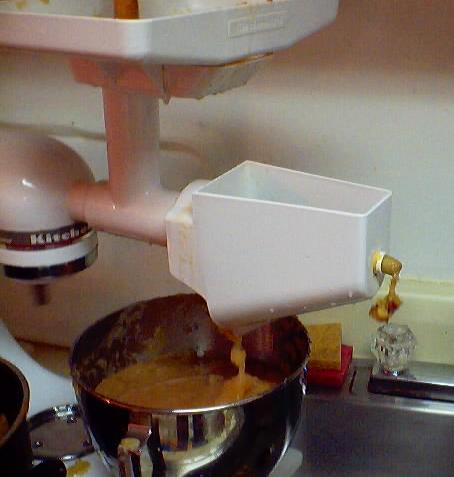 You CAN make applesauce without a
food processor or a £25 foodmill, but it's much
more work, and really only suitable for making a quart or two of applesauce
at a time...
but it can be done -
Click here
for the directions on making applesauce with NO special equipment
You CAN make applesauce without a
food processor or a £25 foodmill, but it's much
more work, and really only suitable for making a quart or two of applesauce
at a time...
but it can be done -
Click here
for the directions on making applesauce with NO special equipment
The device pushes it against a sieve and the applesauce comes out
underneath (in the chrome pot in the photo at left ), and the debris
shoots out the side into the sink - see photo below.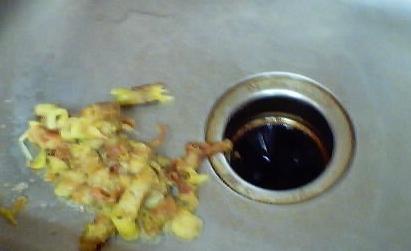
 If the idea of shelling out about
£200 for KitchenAid, plus the additional £120 for the grinder / sieve attachment
doesn't appeal to you, you can still make applesauce using a Foley Food
Mill, pictured at right. You can order one here for much less than
I've seen them elsewhere (see the link below the picture at right and click
for more info). Obviously, you have to crank it by hand, which
is ok if you have child labor and aren't making a lot.
If you are only making a dozen or two jars or don't have other uses for a KitchenAid, then this is a practical alternative.
If the idea of shelling out about
£200 for KitchenAid, plus the additional £120 for the grinder / sieve attachment
doesn't appeal to you, you can still make applesauce using a Foley Food
Mill, pictured at right. You can order one here for much less than
I've seen them elsewhere (see the link below the picture at right and click
for more info). Obviously, you have to crank it by hand, which
is ok if you have child labor and aren't making a lot.
If you are only making a dozen or two jars or don't have other uses for a KitchenAid, then this is a practical alternative.
There is also a VERY nice, versatile strainer pictured at far right! Click on the links there or see the bottom of this page for more information and to order! The VillaWare model can handle higher volumes than a Foley food mill (without giving you cramps!)
Click here for this and related items on Amazon
Click here for this and related items on Amazon
To see a greater variety of
strainers in other types, sizes, and prices, click here!
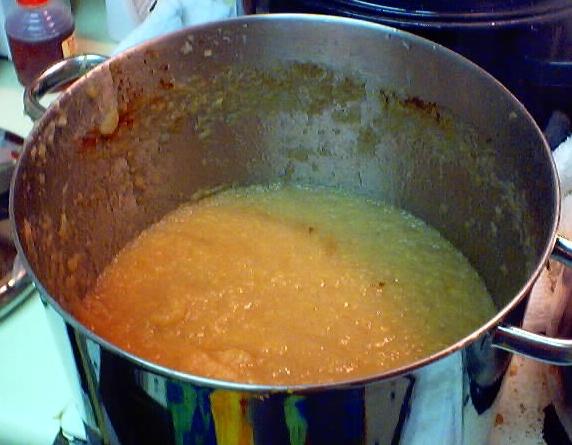 Step 7 - Season and keep the applesauce hot
Step 7 - Season and keep the applesauce hot
Put the applesauce into a large pot. Add cinnamon to taste. You should not need to add any sugar.
The applesauce does not need any further cooking; just keep it hot until you get enough made to fill the jars you will put into the very large pot (Canners hold seven jars at once, whether they are quart or pint size)
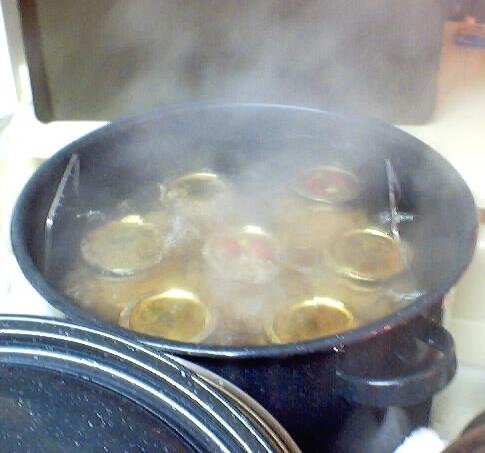 Step 8 - Fill the jars and process them in the water bath
Step 8 - Fill the jars and process them in the water bath
Fill them to within ¼-inch of the top, wipe any spilled applesauce of the top, seat the lid and tighten the ring around them. Put them in the very large pot and keep them cover with at least 1 inch of water and boiling. if you are at sea level (up to 1,000 ft) boil pint jars for 15 minutes and quart jars for 20 min. If you are at an altitude of 1,000 feet or more, see the chart below
.
|
Recommended process
time for applesauce in a |
||||
| Process Time at Altitudes of | ||||
| Quart Size | 0 - 1,000 ft | 1,001 - 3,000 ft | 3,001 - 6,000 ft | Above 6,000 ft |
| Pints | 15 min | 20 | 20 | 25 |
| Quarts | 20 | 25 | 30 | 35 |
\Step 9 - Remove and cool the jars - Done
 Lift the jars out of the water and let them cool without touching or
bumping them in a draft-free place (usually takes overnight) You can then remove the rings if you like. Once the jars are cool, you can check that they are sealed verifying that the lid has been sucked down. Just press in the center, gently, with your finger. If it pops up and down (often making a popping sound), it is not sealed. If you put the jar in the refrigerator right away, you can still use it. Some people replace the lid and reprocess the jar, then that's a bit iffy. If you heat the contents back up, re-jar them (with a new lid) and the full time in the canner, it's usually ok.
Lift the jars out of the water and let them cool without touching or
bumping them in a draft-free place (usually takes overnight) You can then remove the rings if you like. Once the jars are cool, you can check that they are sealed verifying that the lid has been sucked down. Just press in the center, gently, with your finger. If it pops up and down (often making a popping sound), it is not sealed. If you put the jar in the refrigerator right away, you can still use it. Some people replace the lid and reprocess the jar, then that's a bit iffy. If you heat the contents back up, re-jar them (with a new lid) and the full time in the canner, it's usually ok.
Other Equipment:
From left to right:
- Jar lifting tongs
helpful to pick up hot jars - Lid lifter
- to remove lids from the pot
of hot water - Lid
- disposable - you may only
use them once - Ring
- holds the lids on the jar until after
the jars cool - then you don't need them - Bottling jar funnel
- to fill the jars
Summary - Cost of Making Homemade Applesauce - makes 14 quarts* |
||||
| Item | Quantity | Cost in 2009 | Source | Subtotal |
| apples | 1 bushel (about 42 lbs) |
Depends on the apples you choose: as low as 10/bushel for "seconds" to /bushel for Fuji's at a farm market. A good average price is 20/bushel | Pick your own | 20.00 |
| Bottling jars (8 oz size), includes lids and rings | 14 jars | Free, if you save jars and inspect and reuse the lids. | Grocery stores and farm shops often sell bottling jars. | 0 |
| Cinnamon | 1 tablespoon | 0.25 | Grocery stores | 0.25 |
| Total | 20.25 total or about 1.45 per jar |
|||
| * - This assumes you already have the pots, pans, ladles, and reusable equipment. Note that you can reuse the jars! Many products are sold in jars that will take the lids and rings for bottling. For example, Pataks sauces jars work well! | ||||
FAQs - Questions and Answers About Making Applesauce
Q. Can I use a juicer, like a JuiceMan or Vitamix instead of the grinder/sieve? The Juiceman will 'spit out' the pulp and seeds, but the Vitamix uses everything. This is my first time making applesauce and I really don't want to mess it all up.
A. It sounds like the Vitamax isn't appropriate: I'm not sure many people want to eat ground up seeds, stems and cores. In my humble opinion, that's carrying "eat some fiber" to an extreme! :) And it would mostly likely adversely affect the taste.
The Juiceman might work. If it ejects the seeds, stems and hard parts of the core, while allowing the edible apple pulp to pass through, that's what you want.
Since it appears to be designed to "juice" fruit, the applesauce might be ultra-smooth; which could be either a positive or a negative, depending upon your preferences.
Finally, the inclusion of skins in the final product is debatable. The naturalists (hmm, and frugal folks, too) will argue that the skins could and should be ground up and included, as that increases the yield of the applesauce and that's "where the nutrition is" (a statement that I haven't yet seen from credible source, like a major university food science lab). Of course, if any fungicides or pesticides are used, they concentrate in the skin (remember the controversy over Alar?)
If the apples are grown without the use of pesticides or fungicides, then the only concern is the taste, but who knows, you may prefer it with the skins ground in. You don't know till you try!
Q. Can I use a blender for making apple sauce instead of a food mill or food processor?
Certainly! Of course, you’ll need to peel, cut, core and manually remove the seeds first, before you cook the apples; unless you want them all blended up into the applesauce. I get letters from people say they prefer it that way. I think I’ll keep using the strainer…. But sure, aside from the extra work in preparation , you can use the blender.
Q. I was wondering if the applesauce recipe could be frozen and then used?
Yes, absolutely! There’s not much difference in flavor (applesauce cans very well), so most people can it rather than freeze, because of space limitations in their freezer. In a good deep freeze, it should easily last a year.
Q. I have a question about bottling applesauce. Some of mine bubbled over
in the canner.
The lids made a good seal, however. I wanted to know if I can
consider these canned or do I have to keep them in the fridge?
Since they sealed and they were processed in the water bath, they should be fine! It sounds like the jars were filled too full (not enough headspace) or allowed to cool between filling and putting them in the hot water bath.
Q. Have you heard of strawberry-applesauce? Can it be "canned" at home?
Yes, I have made it fresh. I have not found a lab-tested USDA or University sanctioned recipe for strawberry applesauce, but since both strawberries and apples are acidic, safe to can in a water bath canner, high sugar, and pureed, I'd have to believe that a mix of the two would be equally safe. Understand, this is just my layman's estimation, not based on a lab test. If I were to can it, I'd use the recipe above and simply replace and 20% of the apples with strawberries, adding the hulled whole strawberries in with the chopped apples in step 5.
ello, I made applesauce and canned for the very first time last week. I put the boiling applesauce in the jars and sat the jars on the counter and they sealed on their own. I did not know I was suppose to use a water canner or pressure cooker. Now that I have done more research I know that I should have used a water canner. Is all of my applesauce fine since it all the lids sealed or should I be worried? '
Well, the USDA and universities will argue that it was not sterile, and is risky. The sealing was due merely to the cooling of expanded heated water, but is completely unrelated from any assurance of a sterile condition. I think you will find that the rate of spoilage could be high compared with water bath processed jars of applesauce.
The risk of botulism still exists. And since botulism spoilage has no taste, colour, odor or gas, it is undetectable at home.
In short, I’m afraid that there is no answer without lab testing your jars. Some families routinely can without processing, but I don’t think I’d take the risk. See this page for more information.